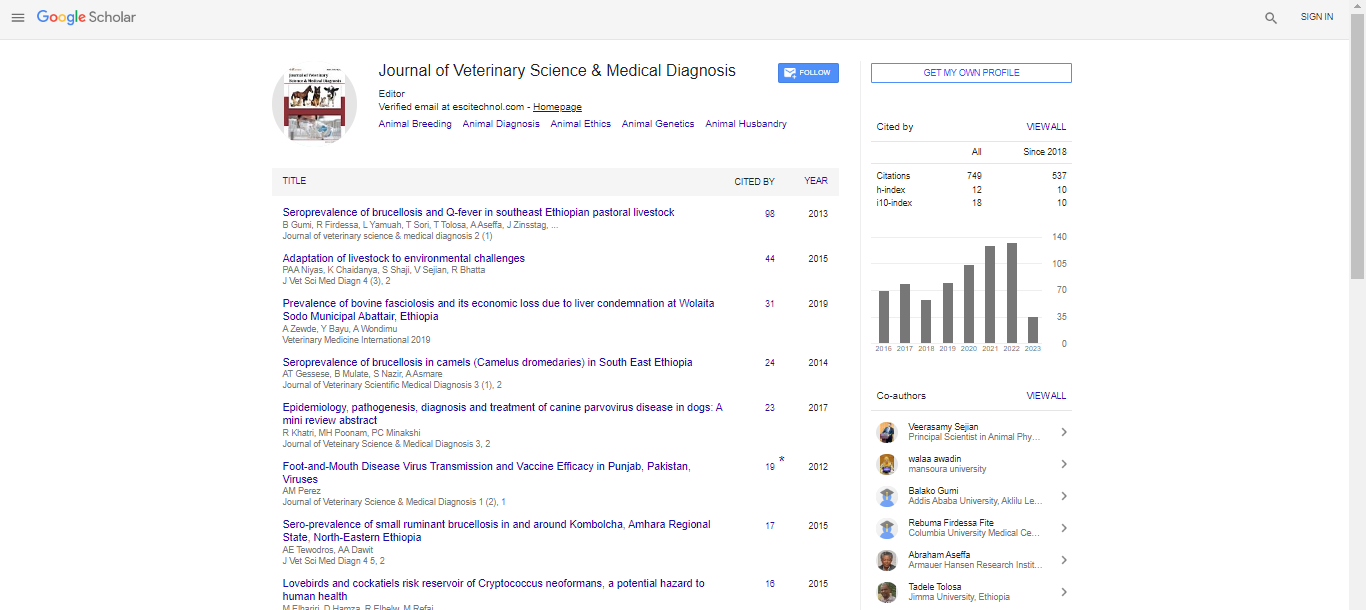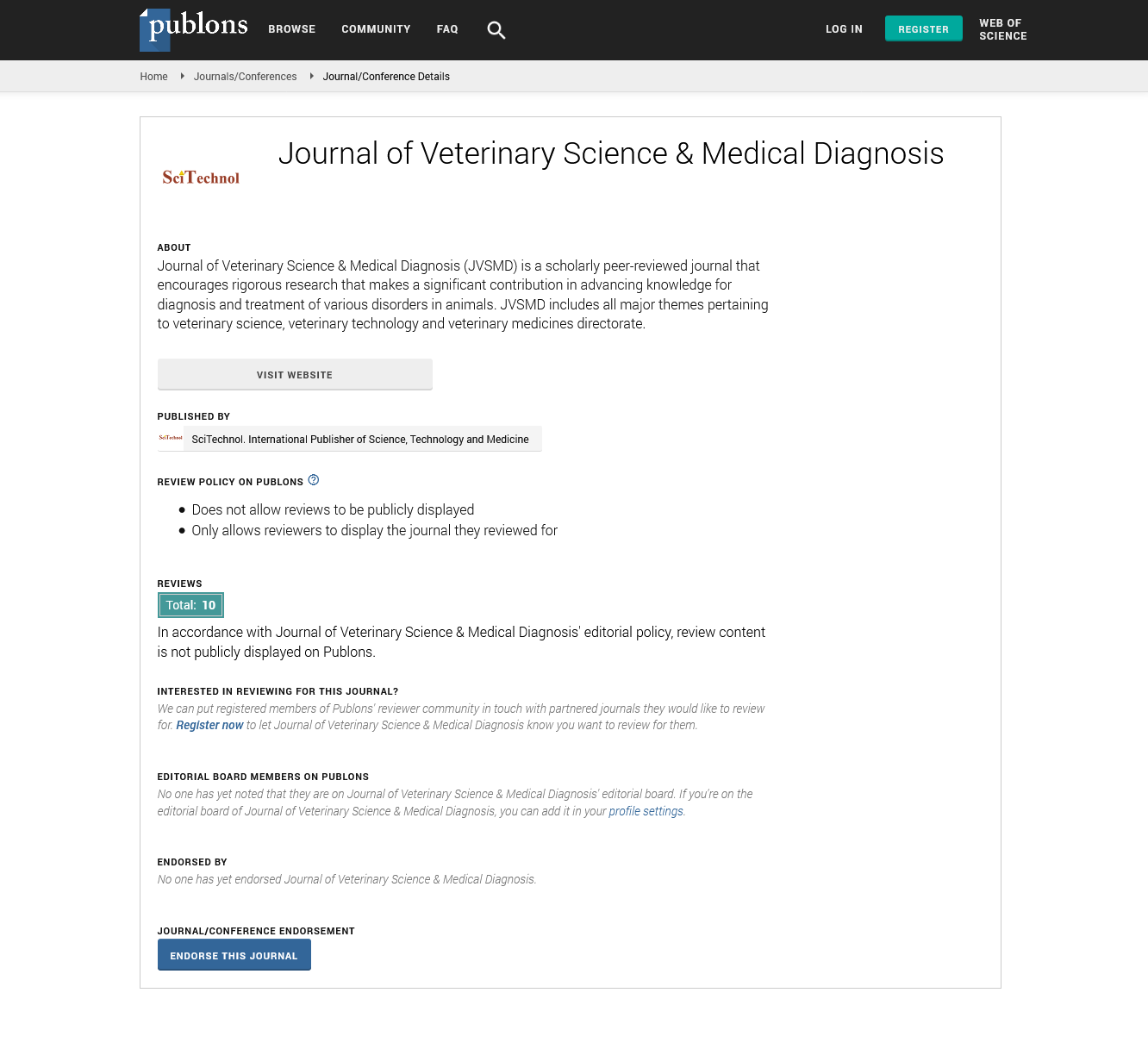Commentary, J Vet Sci Med Diagn Vol: 12 Issue: 4
Pathogenesis and Epidemiology of Leptospirosis
Stephen Barthold*
1Department of Veterinary Pathology, Royal School of Veterinary Studies, Edinburgh, UK
*Corresponding Author: Stephen Barthold,
Department of Veterinary Pathology,
Royal School of Veterinary Studies, Edinburgh, UK
E-mail: Stephen@vet.uk
Received date: 26 Jun, 2023, Manuscript No. JVSMD-23-111847;
Editor assigned date: 29 Jun, 2023, Pre QC No. JVSMD-23-111847 (PQ);
Reviewed date: 13 Jul, 2023, QC No. JVSMD-23-111847;
Revised date: 20 Jul, 2023, Manuscript No: JVSMD-23-111847 (R);
Published date: 27 Jul, 2023, DOI: 10.35248/2325-9590.23.12.1000057
Citation: Barthold S (2023) Pathogenesis and Epidemiology of Leptospirosis. J Vet Sci Med Diagn 12:4.
Description
Leptospirosis is a zoonotic bacterial infection, poses a significant threat to both animals and humans worldwide. This disease is caused by the Leptospira bacteria and is characterized by a range of symptoms that can vary from mild to severe. Understanding the causes, treatment options, and preventive measures of leptospirosis is essential for managing its impact on public health and animal welfare. Leptospirosis is primarily transmitted through contact with the urine of infected animals, which can contaminate soil and water. The bacteria can enter the body through cuts, abrasions, mucous membranes, or by consuming contaminated food or water. Leptospira bacteria thrive in warm and humid environments, making them particularly common in tropical and subtropical regions. Various animal species, including rodents, dogs, cattle, swine, and wildlife, can serve as reservoir hosts, maintaining the bacteria's presence in the environment.
Leptospirosis presents a range of symptoms that can make diagnosis challenging. In animals, symptoms include fever, lethargy, loss of appetite, vomiting, jaundice, and kidney or liver dysfunction. In humans, symptoms can range from mild flu-like symptoms to severe complications such as kidney and liver failure, respiratory distress, and even death in untreated cases. Due to the diverse nature of symptoms and the potential severity of the disease, prompt and accurate diagnosis is essential.
Early detection and treatment is a key to successfully managing leptospirosis. Veterinary and medical care providers typically use antibiotics, such as doxycycline or penicillin, to target the bacteria. In severe cases, hospitalization might be necessary to provide supportive care such as fluid therapy and dialysis to address kidney and liver dysfunction. Treatment success greatly depends on the stage of the disease, the promptness of intervention, and the overall health of the infected individual. Preventing leptospirosis involves a combination of strategies aimed at reducing exposure to contaminated environments and infected animals. Here are important preventive measures: Vaccination is a primary method of prevention for pets, particularly dogs. Leptospirosis vaccines are available and are often included in routine vaccination schedules for dogs. These vaccines target the most common servers of Leptospira bacteria that are prevalent in a given area. Maintaining cleanliness in living environments, both for animals and humans, is important. Proper disposal of waste, avoiding contact with potentially contaminated water sources, and wearing protective gear when handling potentially infected animals can minimize the risk of transmission. As rodents are common carriers of Leptospira bacteria, reducing rodent populations around living areas can help limit the transmission of the disease. This includes implementing rodent-proof storage and waste disposal practices. Raising awareness about leptospirosis among pet owners, farmers, and individuals in high-risk professions can helps to people recognize the symptoms early and seek medical attention or veterinary care promptly. Individuals working in environments with a higher likelihood of exposure, such as farms, wetlands, and areas with stagnant water, should take precautions to minimize contact with potentially contaminated water or soil. Individuals at risk of exposure to contaminated environments, such as veterinarians, animal handlers, and farmers, should wear protective clothing, gloves, and footwear to reduce the risk of infection.
Timely diagnosis and treatment are essential for managing the disease's impact on individuals and preventing its spread. As researchers are studying the complex dynamics of leptospirosis transmission, the collaborative efforts between veterinary and medical professionals, public health agencies, and the general public are essential to effectively mitigate its impact and ensure the well-being of both animals and humans.
 Spanish
Spanish  Chinese
Chinese  Russian
Russian  German
German  French
French  Japanese
Japanese  Portuguese
Portuguese  Hindi
Hindi 
